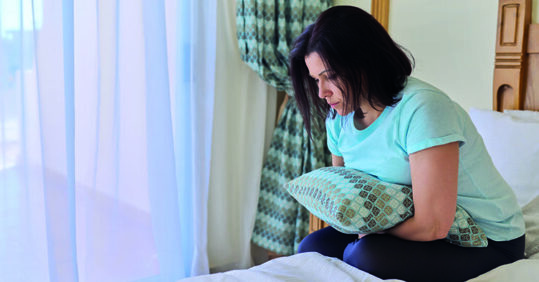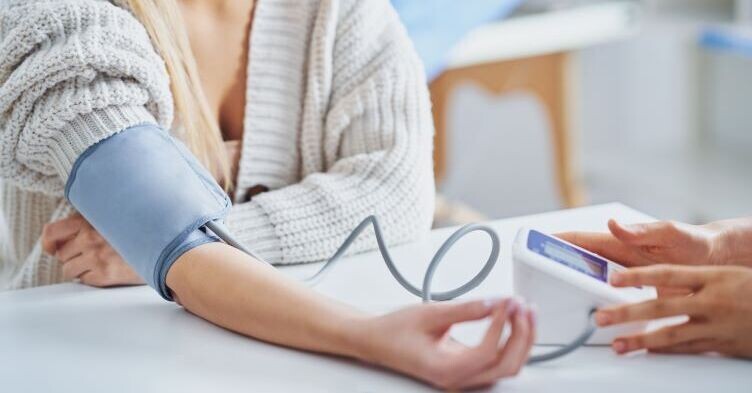How to manage genitourinary symptoms of menopause

GP specialist in women’s health Dr Rebecca Smithson explains how genitorurinary problems can affect women during the menopause and provides an update on management options
Understanding the menopause
Menopause occurs when the menstrual cycle ceases as a result of loss of ovarian function. The time leading up to a natural menopause, when hormone levels are changing, is termed the perimenopause, and postmenopause is the time after the last period. This can be timed precisely after a surgical menopause, but in a natural menopause can only be defined in retrospect when 12 months have passed since the last menstrual period (LMP). The average age of the menopause in the UK is 51; menopause is considered to be early if it occurs between the ages of 40 and 45. If it occurs before the age of 40, it is termed premature ovarian insufficiency.1
What effect does the menopause have on the genitourinary system?
There are oestrogen and progesterone receptors in the vagina, urethra, bladder and pelvic floor muscles. As hormone levels fall, tissues become thinner, drier and less elastic. This can lead to a variety of symptoms and signs, which are collectively known as genitourinary syndrome of menopause (GSM).2 Common signs and symptoms are outlined in Box 1.3
Box 1: Common signs and symptoms of GSM
Genital
Vaginal dryness; irritation/burning/itching; vaginal/pelvic pain or pressure; vaginal prolapse
Sexual
Dyspareunia; dryness/lack of lubrication; postcoital bleeding; reduced arousal/desire; anorgasmia/dysorgasmia
Urinary
Dysuria; urgency; incontinence – stress and/or urge; recurrent urinary tract infections; urethral prolapse; ischaemia of vesical trigone
Related Article: Diagnosis Connect service will link people to advice from charities
Other
Other pelvic organ prolapse (cystocoele, rectocoele, uterine prolapse)
More so than some menopausal symptoms, such as vasomotor symptoms, GSM symptoms tend to increase over time, and may last for years after the menopause.
How might patients present?
It is not uncommon for patients to present with symptoms of burning and itching, which can be mistaken for candida infections. However, recurrent infections – including vaginal and urinary tract infections – are common with the menopause, due to an increase in the vaginal pH as oestrogen levels fall.1 Patients may attend with discharge, or even bleeding, which of course must be investigated to exclude any other underlying cause. Nurses may pick up signs of vaginal dryness or atrophy at a routine smear test, with tissues looking pale and friable; this can be a chance to discuss symptoms opportunistically. Some patients may not realise their symptoms are caused by hormonal changes, or they may feel inhibited from discussing genitourinary symptoms with their healthcare provider. While 40% or more of those going through the menopause will experience GSM, only 25% will seek help for those symptoms.1
What treatments are available?
Treatments for GSM can be grouped into hormonal and non-hormonal.
Hormonal treatments for GSM
Hormonal treatment is mostly oestrogen based, although some women may find testosterone is helpful for low sexual desire. Oestrogen may be delivered systemically as hormone replacement therapy (HRT), locally, or both. It is important to note that some patients on systemic HRT may still require local oestrogen, and NICE supports the use of local oestrogen in addition to systemic HRT for women with GSM for as long as is required to relieve symptoms.4 Low-dose vaginal oestrogens may be used in some patients in whom systemic HRT is contraindicated, but this should be under the guidance of a menopause specialist.1 Examples of local oestrogens are outlined in Table 1.1
Table 1: Local oestrogen preparations available for GSM treatment1
Estradiol Estriol Estring (7.5mcg/24 hours vaginal ring) Generic (0.01% vaginal cream) Vagifem (10mcg estradiol pessary) Ovestin (0.1% vaginal cream) Gina (10mcg estradiol pessary)
The UK Medicines and Healthcare products Regulatory Agency recently announced that an estradiol local vaginal treatment has been reclassified from a prescription-only medicine to a pharmacy-only medicine, meaning it can be bought over the counter (OTC) from a pharmacy. This 10mcg estradiol pessary, Gina, is now available to buy for women aged 50 or older who have not had a period for a year, following a consultation with a pharmacist. The pessaries are used daily for two weeks, then twice a week. Each pack costs around £29.99 and contains 24 vaginal tablets. Cost may be a consideration for some patients, especially those on low incomes in England who do not usually pay for prescriptions, and those in Wales, Scotland and Northern Ireland where there are no prescription charges.5
The dose delivered by vaginal oestrogens is very small, and endometrial protection with a progestogen is not necessary1, nor is routine endometrial assessment.4 However, all women should be counselled to seek medical attention should they experience any unscheduled bleeding.
Ospemifene is currently not available in the UK, but is a selective oestrogen receptor modulator that exerts an oestrogen-like effect on the vaginal wall.1 It appears to be well tolerated with few side-effects, but more research is needed.3 Intravaginal testosterone and intravaginal dehydroepiandrosterone (a steroid hormone produced by the body) are not currently recommended in the UK.1
Non-hormonal treatments for GSM
Non-hormonal treatments include a range of vaginal lubricants and vaginal moisturisers that are available OTC (see Table 2).1
Table 2: Non-hormonal treatments for GSM1
Vaginal lubricants Vaginal moisturisers YES Replens Sylk Regelle Hyalofemme
Vaginal lubricants relieve dryness at the time of intercourse and can be used alone or with local oestrogen. Lubricants should be applied prior to sexual intercourse. However, patients should be warned that some lubricants (typically those that are oil-based rather than water-based) can compromise the integrity of condoms and diaphragms.
Vaginal moisturisers are water based and provide longer-lasting relief of vaginal dryness by lining the vaginal wall, mimicking vaginal secretions and lowering the pH. They should be used regularly every few days rather than just before intercourse.3
Related Article: CVD prevention must be national health priority, says report
The use of phytoestrogens and herbal supplements, such as black cohosh, is not currently supported by evidence of efficacy for GSM.3
A form of laser treatment showed some benefit for GSM in a small study, but is not widely available, and further research is needed.3
What about the pelvic floor?
The pelvic floor muscles support the pelvic organs, including the uterus, bladder and rectum. Along with other mechanisms (such as childbirth and straining), the pelvic floor can be weakened by the reduction in hormone levels due to the menopause. This can lead to stress incontinence. This may be a problem that women find embarrassing to discuss, so it is worth enquiring about these symptoms when seeing menopausal patients in practice.
Patients should be encouraged to engage in pelvic floor exercises regularly. These exercises can be described as ‘lift and squeeze’ – pulling the back passage up and forwards as if you are trying to stop breaking wind, but without clenching the buttocks. Hold the squeeze for up to a count of 10 and release, followed by 10 quick squeezes. These exercises should be repeated three times a day for women experiencing severe symptoms (although they may need to work their way up to being able to hold on for a count of 10).
As symptoms respond to the exercises, they can be done less often but should still be performed regularly. A good tool for women to use is the Squeezy app, which costs £2.99 but will help them understand how to perform pelvic floor exercises, as well as sending reminders.6
Let’s talk about sex
Average life expectancy for women in the UK is 83 years.7 A fulfilling sex life does not need to end at the menopause. Female sexual dysfunction may be related to pain and dryness from GSM but there may also be contributions from other menopausal symptoms, such as low mood, altered body image and fatigue due to night sweats. The average age of divorce for women is widely quoted to be around 44 years, and conflict within a relationship may contribute to sexual dysfunction. Although sexual desire and sexual activity tend to decline with age, 26% of people aged 75-85 may still be engaging in sexual activity,8 so it is important to support people experiencing challenges in their sex life to ensure they can continue to enjoy sexual relations for as long as they wish.
It is important to consider contraception. Although fertility declines with age, it is still possible to conceive in the perimenopause. The rate of conception for 50-year-old women is variously quoted as between 2% and 5%, although this will include assisted conceptions as well as spontaneous pregnancies. If women have previously been having periods, they are advised to continue contraception for at least two years after their last menstrual period if aged under 50, and at least one year if over 50. For women who are not having periods (for example because of a hormonal contraceptive) the advice is to continue contraception until the age of 55.9
The menopause does not protect against sexually transmitted infections (STIs), and of course the same advice that would be given to any person regarding STIs should still be given to anyone in the perimenopause and postmenopausally.
Dr Rebecca Smithson is a GPSI in women’s health in Scotland
Related Article: Postnatal contraception advice reduces the risk of back-to-back pregnancies
References
- Hillard T et al. Management of the Menopause (6th Edition). Plymouth: British Menopause Society, 2021
- Portman D, Gass M and the Vulvovaginal Atrophy Terminology Consensus Conference Panel. Genitourinary syndrome of menopause: new terminology for vulvovaginal atrophy from the International Society for the Study of Women’s Sexual Health and The North American Menopause Society. Climacteric 2014;17:5:557-563. Link
- Angelou K et al. The Genitourinary Syndrome of Menopause: An Overview of the Recent Data. Cureus 2020;12:4:e7586. Link
- NICE. Menopause: diagnosis and management. London: NICE, 2019. Link
- British Menopause Society. First clinically proven treatment for vaginal atrophy after menopause to be available for purchase in pharmacy. Marlow: BMS, 2022. Link
- Squeezy. Link
- Office for National Statistics. National life tables – life expectancy in the UK:2018-2020. ONS, September 2021. Link
- Lindau S et al. A study of sexuality and health among older adults in the United States. N Engl J Med 2007;357:762-774 Link
- Women’s Health Concern. Contraception for the older woman factsheet. Marlow: WHC, 2019.
Link

See how our symptom tool can help you make better sense of patient presentations
Click here to search a symptom




